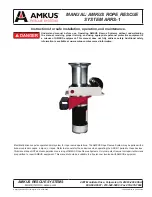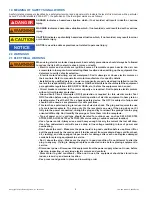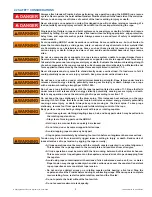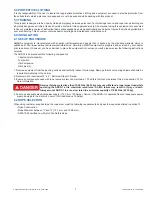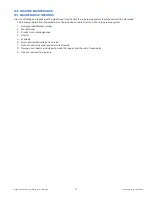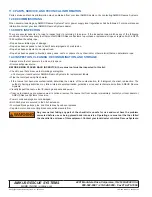
©Copyright Amkus Rescue Systems, Inc. 2018-2020
LAA-002 March 10, 2020 Rev02
4
1.0 MEANING OF SAFETY SIGNAL WORDS
A safety related message is identi
fi
ed by a safety alert symbol and a signal word to indicate the level of risk involved with a particular
hazard. Per ANSI standard Z535.6-2011, the de
fi
nitions of the four signal words are as follows:
DANGER
DANGER indicates a hazardous situation which, if not avoided, will result in death or serious
injury.
WARNING
WARNING indicates a hazardous situation which, if not avoided, could result in death or serious
injury.
CAUTION
CAUTION indicates a potentially hazardous situation which, if not avoided, may result in minor
or moderate injury.
NOTICE
NOTICE is used to address practices not related to personal injury.
2.0 WARNINGS
2.1 ELECTRICAL WARNING
WARNING
When using electric motorized equipment, basic safety precautions should always be followed
to reduce the risk of
fi
re, electric shock, injury, or death;
• Electric motor and controls are ignition sources. Flammable vapors heavier than air can
accumulate in low spots. Avoid selecting these locations when setting up the equipment. Use
detectors to verify safe site selection.
• Electric motor and wiring are not waterproof. Don’t submerge or douse electric motors or
their controls. Refer to manuals from motor manufacturer for speci
fi
c details.
• Installation by quali
fi
ed person – power componentry properly sized and installed to run the
tool are the responsibility of the purchaser. Quali
fi
ed electricians should install the equipment
per applicable regulations (NEC, NFPA, OSHA, etc.) before the equipment can be used.
• Circuit breakers matched to the motor capacity are required. Don’t operate electric motors
without circuit breaker protection.
• Ground Fault Circuit Interrupter (GFCI) protection is required for this electric motor. Test
GFIC function before using the motor. Avoid operation of electric equipment in heavy rain or
standing water. Treat the GFCI as a backup safety device. The GFCI is subject to failure and
should not be used as a replacement for safe practices.
• This tool has a polarized plug to reduce risk of electric shock. The plug and requires the use
of a matched receptacle. The plug only
fi
ts the receptacle one way. If the plug does not
fi
t
fully into the power connection, re-align the plug and try to reinsert the prongs into the plug
oriented di
ff
erently. Don’t modify the prongs or force them into the receptacle.
• Type of power cord - cord type should be rated for outdoor use, such as SW, SOW, STW,
STOW, SJW, SJOW, SJTW, or SJTOW. (W service rating = outdoor and wet location)
• Use of power cords - Always use a cord heavy enough to carry the current the tool will draw.
Use of an undersized cord will cause a drop in line voltage resulting in loss of power and
overheating.
• Don’t abuse the cord – Make sure the power cord is in good condition before use. Never lift or
pull the equipment by the cord or yank it to disconnect from receptacle. Keep cord from heat,
oil, crushing, and sharp edges. Inspect cords for damage after each use. Replace damaged
cords before placing equipment in service.
• Don’ t abuse the plug – Make sure the plug is in good condition. Do not attempt to alter the
plug in any way. If plug is damaged replace connected cords before placing equipment in
service.
• Disconnect power –Disconnect the equipment from the power supply when not in use, before
cleaning, inspecting, or servicing electric motors and controls.
• Store motor in good conditions – When not in use, the equipment should be stored in an
indoor, clean, dry, and secure location.
• Keep covers and guards in place and in working order

